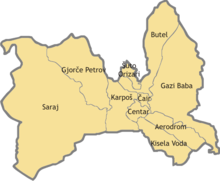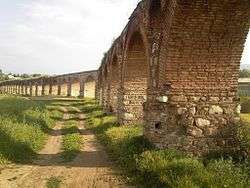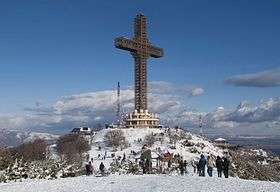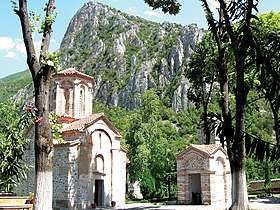Skopje/Outer Skopje
Outer Skopje consists of the territory of the City of Skopje outside of Centar and the Stara Čaršija (Old Town). This large and diverse area of the city is generally less densely populated. It consists of both urban neighbourhoods and older villages now within the borders of the capital. Important archaeological sites, the Skopje Zoo, and medieval churches can be found here. There is also a lot of nature to be explored, particularly at Matka Canyon and Vodno Mountain.
Understand
The Republic of North Macedonia is divided into 80 municipalities, ten of which form the City of Skopje. Centar and Čair contain the central area of Skopje, both modern and historic. The other eight municipalities are primarily residential, either urban or rural. However, some of Skopje's most important sites can be found in Outer Skopje.
The type of people amongst which you find yourself can vary greatly depending on which part of the city you are in. Aerodrom, Gjorče Petrov, Karpoš, and Kisela Voda are predominantly ethnic Macedonian and Orthodox Christian. Butel and Gazi Baba also have large Macedonian majorities but with significant Albanian minorities. Saraj is predominantly ethnic Albanian and Muslim. Šuto Orizari is predominantly Roma (Gypsy) and Muslim.
The Republic of North Macedonia is divided into eight regions, of which the Skopje Region consists of the City of Skopje and several surrounding municipalities. This guide also covers those surrounding municipalities which include Aračinovo, Čučer-Sandevo, Ilinden, Petrovec, Sopište, Studeničani, and Zelenikovo.
Get in

By bus
All of the municipalities of Outer Skopje can be reached by bus from Centar. From Aerodrom going clockwise:
- Aerodrom can be reached via lines 3, 5, 7, 15, 17, 20, 21, and 45.
- Kisela Voda can be reached via lines 4, 14, 24, 31, 51, 58, 67, 70, 74, 75, and 80.
- Karpos can be reached via lines 3, 9, 14, 24, 57 and 60.
- Saraj can be reached via lines 2, 11, 12, 56, and 60.
- Gjorče Petrov can be reached 4, 5, 11, and 64.
- Šuto Orizari can be reached via lines 19, 29, and 40.
- Butel can be reached via lines 8, 47, 48, 57, 59, 61, 71, and 77.
- Gazi Baba can be reached via lines 2, 10, 12, 16, 26, 45, 50, 52, 53, 54, 56, 62, 63, 65, 66, and 68.
By taxi
The bus system is efficient and cheap enough that an often overpriced taxi can be avoided. However, a taxi retrieved in central Skopje will drive anywhere to the outer parts of Skopje. The price, of course, will vary depending on which part of the city. A trip to Matka Canyon, for example, may cost around 800 denars, while a trip down to the end of the quay in Aerodrom should be up to a few hundred denars.
See
Aerodrom
Despite its name, Aerodrom (meaning "airport") is not home to Skopje's main airport which is outside the city in the village of Petrovec. Its name is the result of being home to a military airport in the early 20th century. The municipality is mostly residential and most settlements are relatively new.
- 🌍 Cevahir Sky City (Џевахир Скај Сити), Boulevard Serbia 31A, Skopje 1000. The skyscrapers, which are under construction, are the tallest in North Macedonia. The four towers, each rising 142 m (466 ft), will be connected by a mixed-use building containing a shopping mall and sports facilities. The development is expected to be completed in 2017.
Butel

Butel consists of urban neighbourhoods close to the city centre as well as historic villages that now happen to find themselves within an evergrowing city.
- 🌍 Skopje Aqueduct (Скопски аквадукт). Located within the village of Vizbegovo, this is the only aqueduct archaeological site in North Macedonia and one of three in the former Yugoslavia. Its date of construction is not known; it may have been built as early as Roman times or as late as early Ottoman rule. The stone and brick structure was used as an aqueduct until the 18th century. Today, 386 meters (1,266 feet) consisting of 55 arches remain. It is on the Serava River and, presumably, carried water from a spring in the Skopska Crna Gora to the city centre.
Karpoš
- 🌍 Scupi (Скупи). Not a great deal remains of the ancient Dardanian and Roman city of Scupi. It was once the capital of Dardania and then fell under Roman rule when Dardania was annexed by the Romans. It was abandoned in 518 after an earthquake destroyed most of the city. The residents likely moved to what is now the Skopje Fortress. Byzantine Emperor Justinian I, a Skopje-area native, is believed to have used materials from Scupi to construct the new settlement at today's fortress. The remains at the site include gravestones, walls, and some pillars. Some of the remains contain interesting detail and inscriptions but Scupi should only be on your list of places to see if you have an excess of time in Skopje. Many of the major findings, such as the statue of Venus, can be found at the Museum of Archaeology.
- 🌍 Skopje Zoo (Зоолошка градина Скопје), ☎ +389 2 322 0578. Daily 09:00-18:00. Founded in 1926, the Skopje Zoo now boasts roughly 300 animals from 85 species. It covers 12 hectares (30 acres) right next to the City Park. After a history of poor living conditions for animals, in 2008 the city invested money in bringing animal habitats up to European standards, making the zoo a much more enjoyable place to visit.
- 🌍 Macedonian Museum of Natural History (Природонаучен музеј на Македонија), Bull. Ilinden 86. Next to the Skopje Zoo.

- 🌍
Mount Vodno (Водно). Vodno, the mountain visible from all of central Skopje, stands southwest of the city centre with its highest peak at a height of 1,070 m (3,500 ft). A destination for recreational activities, it is also home to major places of interest. The Millennium Cross sits on its highest peak, which is accessible via a 1.75-km (1.01-mi) long cable car. A 12th-century monastery is located in one of the villages that dot the mountain. There are also natural sights, such as waterfalls, streams, and springs.
- 🌍
Millennium Cross (Милениумски крст), ☎ +389 70 806 626. The cross, erected in 2002, stands on Vodno's highest peak. It was built to commemorate 2,000 years of Christianity in the world. It is 66 m (217 ft) tall and has an elevator within it. It also now has a restaurant and souvenir shop next to it. As sits on the most prominent peak in the area, it provides expansive views of the city.
- 🌍 Millennium Cross Cable Car (Жичница „Милениумски крст“). Opened in 2011, the Millennium Cross Cable Car runs from Middle Vodno, home to Hotel Vodno and a relatively new monastery, to the cross. The 28 gondolas fit eight people each and can hold bicycles on the exterior. A city bus runs to the bottom station at Middle Vodno. 100 denars.
- 🌍 Church of St Pantaleon (Црква „Св. Пантелејмон“). About halfway up Vodno in the village of Gorno Nerezi is the monastery containing the Church of St Pantaleon. The church was built 1164 and much of its frescoes, as well as the marble iconostasis, remain intact. Some of the frescoes depict the Passion of the Christ. The cross-shaped church has one main dome. The position of the monastery makes it an excellent location for a view of Skopje.
- 🌍 Macedonian Village (Македонско село), ☎ +389 72 220 600. Within the village of Gorno Nerezi, this complex is a reconstruction of the traditional architecture and buildings found within a Macedonian village. It has a restaurant and the complex's location on Vodno gives it great views over Skopje.
- 🌍 Telecommunication Tower (Телекомунациска кула). Under construction next to the Millennium Cross is a telecommunication tower. It is planned to have a twist shape with multiple circular pods.
- 🌍
Millennium Cross (Милениумски крст), ☎ +389 70 806 626. The cross, erected in 2002, stands on Vodno's highest peak. It was built to commemorate 2,000 years of Christianity in the world. It is 66 m (217 ft) tall and has an elevator within it. It also now has a restaurant and souvenir shop next to it. As sits on the most prominent peak in the area, it provides expansive views of the city.
Saraj
.jpg)

Saraj is the largest municipality by area in Skopje. It is completely rural, including expansive nature like Matka Canyon, and was added to the city limits in the early 2000s. As Saraj as a whole is primarily Albanian-inhabited, its addition to the city bumped the proportion of Albanians in Skopje to 20%.
- 🌍
Matka Canyon (Матка кањон). One of the most popular outdoor destinations in Macedonia, Matka Canyon is formed by the river Treska, a tributary of the Vardar which has been dammed forming a lake also called Matka. It is home to 10 caves with depths of 20 m (66 ft) to likely over 176 m (578 ft) and a great diversity of wildlife including 77 indigenous specifies of butterfly. Aside from the nature, a major draw of the canyon is its numerous medieval churches and monasteries.
- 🌍 St Andrew's Monastery (Манастир „Св. Андреја“). Located on the west bank of the Treska gorge, St Andrew is a well-frequented monastery due to its scenic and easily accessible location at the foot of the rocks and mountains standing above the gorge. It was built in 1389 and contains very well-preserved frescoes. It contains a restaurant, a cafe, and canoe/kayak rentals.
- 🌍 Šiševo Monastery (Шишевски Манастир). This monastery, which contains the Church of St Nicholas, was likely established in the 14th century, possibly by King Marko. It was abandoned a couple times during its history and the monastery complex, excluding the church, were burned down in 1844. The church, in the Byzantine style, has an octagonal dome and a porch. Above the entrance is a large mural of St Nicholas. Situated above high above the canyon at the foot of a large rock, it is a popular rest stop for hikers.
- 🌍 Church of St Nedela (Црква „Св. Недела“). A ruined church on the west side of the canyon. While just walls and arches remain, there are icons within it as well as places to light candles.
- 🌍 Church of the Holy Saviour (Црква „Св. Спас“). On the west side of the canyon, this small church dates from the 14th century. It was in rough shape for many years but is now well maintained.
- 🌍 Matka Monastery (Манастир Матка). This monastery, dedicated to the Holy Mother of God, sits on the west side of the Treska River. It is home to an active female monastic sisterhood. The 14th century monastery is one of the more easily accessible of the canyon area. According to an inscription on the church, someone named Milica found the church in poor condition and without a roof in 1497. She replaced the roof, added new frescoes, built a portico and created a vineyard. The church within is in the Byzantine style and has an octagonal dome.
- 🌍 Church of St Athanasius (Црква „Св. Атанасиј“). Just east of the Treska River on a small hill within the village of Šiševo is the Church of St Athanasius. It dates from the 14th century, though most of it is newer than that.
Further afield
There are some sights found outside of the City of Skopje but within the Skopje Region, which is one of the eight statistical regions that form North Macedonia.
- 🌍 Marko's Monastery (Марков Манастир) (village of Markova Sušica, 18 km south of central Skopje). Continuously active since its establishment in 1346, Marko's Monastery bears the name of Serbian Prince Marko who reigned at the time of its completion. It consists of one church dedicated to St Demetrius. The church was built of bricks and stones and its iconostasis is made of stone pillars. The monastery grounds also consist of lodgings, a belfry, a well, warehouses, a bakery, and a mill. Marko's Monastery did not suffer under the Ottoman-era, unlike many churches and monasteries, and in 1830 an Ottoman aristocrat even added an exonarthex to the church.
- 🌍 Tauresium (Тауресиум) (village of Taor, 20 km southeast of central Skopje). This archaeological site is best-known as the birthplace of Byzantine Emperor Justinian I in 483, though King Theodahad of the Ostrogoths was also born here in 480. The ruins today mostly consist of building foundations and short walls.
- 🌍 Monastery of St Nicetas (Манастир Свети Никита) (village of Banjane, 16 km north of central Skopje). This medieval church was built around 1300 by Serbian King Milutin on the ruins of an older church. It is in a typical Byzantine style, made of stone and red brick. The frescoes inside the church date from around 1324, with the exception of those in the dome which date from the 19th century. The iconostasis was painted in 1847. Banjane is also home to the 16th century Church of St George, significant for its frescoes.
- 🌍 Marko's Towers (Маркови Кули) (village of Letevci, 53 km southeast of central Skopje). Ruins of a fortress built in Late Antiquity. Today, the most prominent portion of the ruins is a tower that overlooks the modern A1 highway, and the Pčinja River.
Čučer-Sandevo Municipality
North of central Skopje, bordering Kosovo, and containing much of the Skopska Crna Gora mountain range.
- 🌍 Brazda Archaeological Park (Gradište, Археолошки парк Бразда, Градиште) (village of Brazda, 15 km north of central Skopje). This archaeological site dates from the 5th-4th centuries BC. Around this time, the area was inhabited by the Agrian tribe of Paeonians, however ceramic findings at the site indicate it may have been an Athenian settlement. The walls of the tombs also bear a decorative technique thought to be a mark of the Athenians. It is situated on a hill just south of the village. Until 2012, the site was rather neglected but then underwent a major cleanup.
- 🌍 Kučevište Monastery (Кучевишки манастир) (village of Kučevište, 15 km north of central Skopje). On the slopes of the Skopska Crna Gora mountain range is this monastery, established in the 14th century in the village of the same name. Its main church is dedicated to the archangels Michael and Gabriel. It was built between the Marička Battle of 1371 and the Battle of Kosovo of 1389. The interior was not painted until 1591 and the current iconostasis dates from the 19th century.
- 🌍 Church of the Holy Saviour (Црква „Св. Спас“) (village of Kučevište, 15 km north of central Skopje). This medieval Orthodox church is actually dedicated to the Holy Mother of God but is called St Spas because it celebrates Spasovden (the Feast of the Ascension). Built in the Byzantine style, it was completed in the 14th century. The current frescoes were painted in 1874. In 1501, a secret chapel was built within the church but never discovered by the Ottomans during their entire rule.
Do
- Walk the Vardar Quay. The quay runs from Park Aerodom at ASNOM and Kiro Gligorov boulevards in the east down to Centar in the west. Portions east of Park Aerodrom are under construction. Along the quay are bike lanes, walking lanes, pull-up and push-up bars, parks, and cafes.
Sports
- 🌍 Boris Trajkovski Sports Center (Спортски центар Борис Трајковски), ☎ +389 2 308 9600. A modern arena home to the Macedonian national basketball, handball, and volleyball teams for both men and women. It also hosts concerts. Its maximum capacity is 8,000 for sports events.
Buy
.jpg)
- 🌍 Skopje City Mall (Скопје Сити Мол), ☎ +389 2 325 3990. Daily 10:00-22:00. Skopje's large indoor shopping mall home to stores like Zara, Nike, etc. It also features a food court and cinema.
Eat
- 🌍 Hunter's Lodge Kamnik, ☎ +389 2 252 3522. Great fresh wild meat, great wine, and great hunting lodge atmosphere. A tad more expensive than the average Skopje restaurant, but well worth it.
Drink
- 🌍 VOX Night Club. In Karpoš. A nightclub usually crowded on weekends.
Sleep
- 🌍 Hotel Russia, ☎ +389 2 240 0030. On the Vardar River in Aerodrom, Hotel Russia opened in the early 2010s. A restaurant on top of the hotel provides panoramic views of the city. The hotel is situated next to the Jane Sandanski Sports Complex, the Park of Lakes, and also connects to the Vardar Quay.
- 🌍 Hotel New Star, Ul 2 Br. 160 Vizbegovo, ☎ +389 2 260 0333, e-mail: newstar@newstar.com.mk. This hotel is in the village of Vizbegovo in Butel Municipality. It is near the Skopje Aqueduct which is also within Vizbegovo.